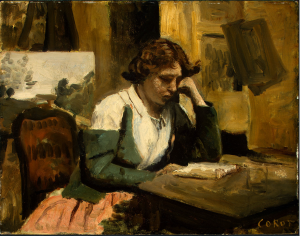
French artist, Jean-Louis-Ernest Meissonier (1815- 1891) is best known for painting miniatures in oils, with scrupulous attention to detail. He specialised in scenes of bourgeois domestic life from the 17th and 18th centuries, portraying his subjects playing chess, smoking pipes, reading books, sitting near musical instruments, or posing in the uniforms of musketeers.
He had only a brief artistic education and was largely self-taught, carefully studying the Dutch, Flemish and French painters at the Louvre.
His first submission to the Paris Salon, before he turned 20, was in 1834. Flemish Burghers, 1833-4 was a small costume piece featuring three gentlemen clad in traditional 17th century clothing. Following the success of this painting at the Salon, Meissonier painted numerous paintings in a similar style and became the most sought after painter of the decade, appealing to a wide range of collectors.

However, in the late 1840s his style changed.
It was during the 1848 revolution in Paris, as a captain in the National Guard, that Meissonier led the troops responsible for defending the Hôtel de Ville.
It was here he witnessed the carnage of the battle first hand and in response he painted one of his most significant paintings: Memory of the Civil War, also known as The Barricade. (Meissonier painted this picture after a watercolour (Musée du Louvre) done at the scene on June 25, 1848, during the workers’ riots.)
Unlike Delacroix’s romantic painting, Liberty Leading the People, this was an unflinching depiction of the incomprehensible horror of civil war. Piles of bodies lie in the street in varying stages of decomposition after the barricade had been stormed at the Hôtel. Blue and white shirts, stained with blood, create a grim “tricolour”.

The painting is extremely realistic, Meissonier having painted every part of the canvas, the cobblestones and as the rioters, with the same attention to detail. Unlike historical paintings generally, the work seems to portray a scene observed without comment or message – which is why it is considered to be a Realist painting.
The painting received a great deal of attention when it was exhibited at the Paris Salon of 1850-51 (known that year as the “Realist Salon” as there were so many realist paintings on exhibition) and is considered to be the most powerful image to emerge from the events of 1848.*
It was from about this time that he also painted large military and historical scenes, including such works as Friedland, 1807, painted between 1861-75.

Meissonier worked with elaborate care and scrupulous observation, and some of his works took up to 10 years to complete.
In 1889 he accepted the position of president of the Exposition Universelle, France’s extravaganza celebration of the centennial of the Revolution – for which the Eiffel Tower was designed. He exhibited 19 paintings at the Exposition and became the first artist to be awarded the Grand Cross of the Legion of Honour.
Unflagging in his commitment to the arts, he also helped to establish the independent Société Nationale des Beaux-Arts the following year, and became its first president for a brief period prior to his death in 1891.
* Primary Source: The Louvre
In my next blog I will move on to discuss Impressionism and some of the key artists and artworks from that period.
This is an excerpt from my e-course, Introduction to Modern European Art.
